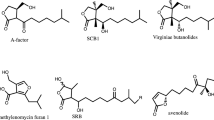Abstract
Streptomycetes are the most important source for antibiotics. One representative species is Streptomyces pristinaespiralis–the producer of pristinamycin. Pristinamycin biosynthesis is governed by a complex signalling cascade consisting of seven different transcriptional regulators. Understanding the signalling cascade can help to optimize antibiotic production processes in general but also allows to targetedly activate silent gene cluster expression in order to find new antibiotics.
Similar content being viewed by others
Literatur
World Health Organization (WHO) (2011) Antimicrobial resistance: no action today, no cure tomorrow. WHO Press, 7 April 2011, http://www.who.int/world-health-day/2011/en/index.html
Chen L, Todd R, Kiehlbauch J et al. (2017) Notes from the Field: Pan-Resistant New Delhi Metallo-Beta-Lactamase-Producing Klebsiella pneumoniae–Washoe County, Nevada, 2016. MMWR Morb Mortal Wkly Rep 66:33, doi: 10.15585/mmwr.mm6601a7
Mast Y, Wohlleben W (2014) Streptogramins–two are better than one! Int J Med Microbiol 304:44–50
Mast Y, Weber T, Gölz M et al. (2011) Characterization of the ‘pristinamycin supercluster’ of Streptomyces pristinaespiralis. Microb Biotechnol 4:192–206
Harms JM, Schlünzen F, Fucini P et al. (2004) Alterations at the peptidyl transferase centre of the ribosome induced by the synergistic action of the streptogramins dalfopristin and quinupristin. BMC Biol 2:4
Mast Y, Guezguez J, Handel F et al. (2015) A complex signaling cascade governs pristinamycin biosynthesis in Streptomyces pristinaespiralis. Appl Environ Microbiol 81:6621–6636
Bibb M (2005) Regulation of secondary metabolism in streptomycetes. Curr Opin Microbiol 5:208–215
Tanaka A, Takano Y, Ohnishi Y et al. (2007) AfsR recruits RNA polymerase to the afsS promoter: a model for transcriptional activation by SARPs. J Mol Biol 369:322–333
Rutledge PJ, Challis GL (2015) Discovery of microbial natural products by activation of silent biosynthetic gene clusters. Nat Rev Microbiol 13:509–523
Malpartida F, Niemi J, Navarrete R et al. (1990) Cloning and expression in a heterologous host of the complete set of genes for biosynthesis of the Streptomyces coelicolor antibiotic undecylprodigiosin. Gene 93:91–99
Author information
Authors and Affiliations
Corresponding author
Rights and permissions
About this article
Cite this article
Mast, Y. Kontrollierte Biosynthese eines synergistischen Wirkstoffpaares. Biospektrum 23, 594–596 (2017). https://doi.org/10.1007/s12268-017-0841-1
Published:
Issue Date:
DOI: https://doi.org/10.1007/s12268-017-0841-1




